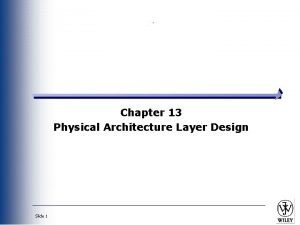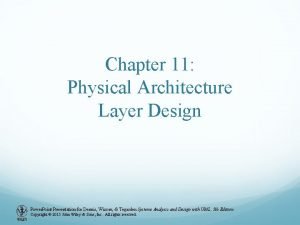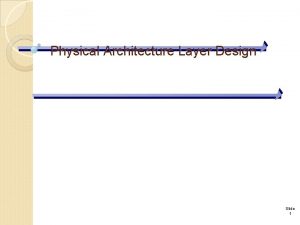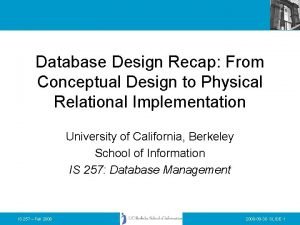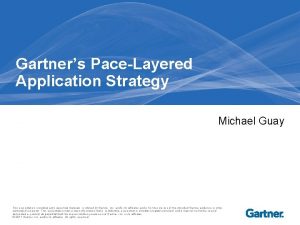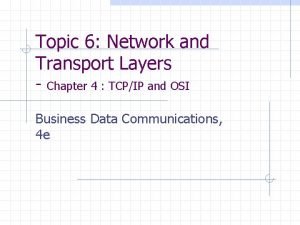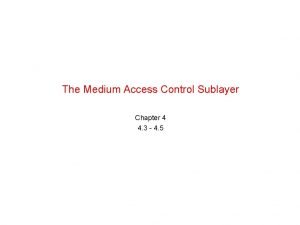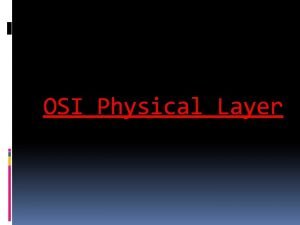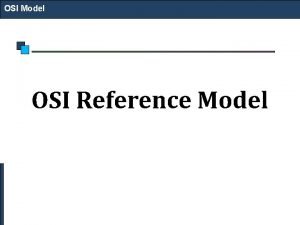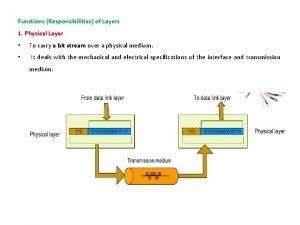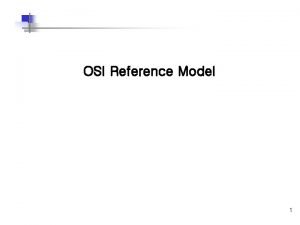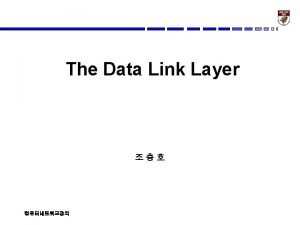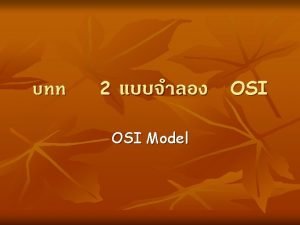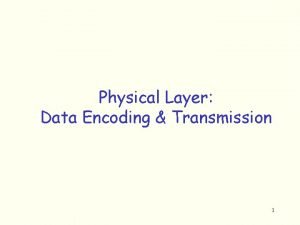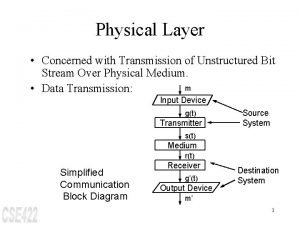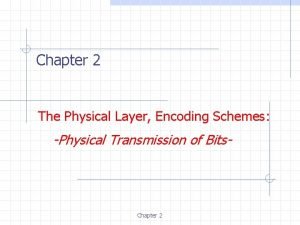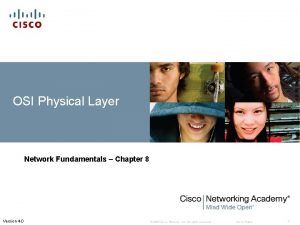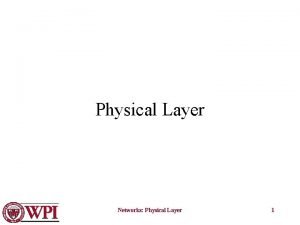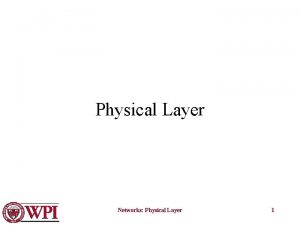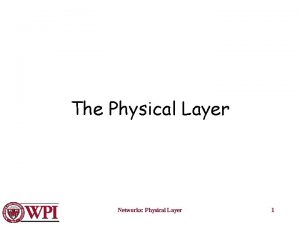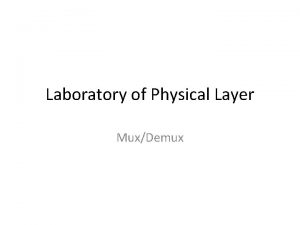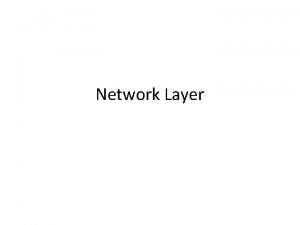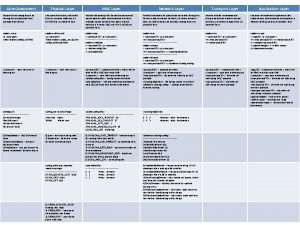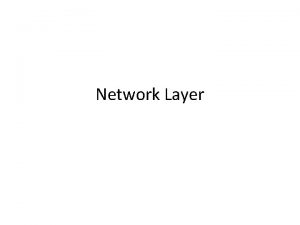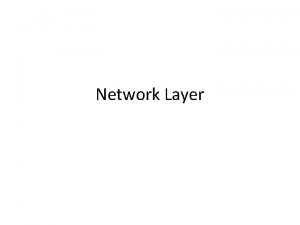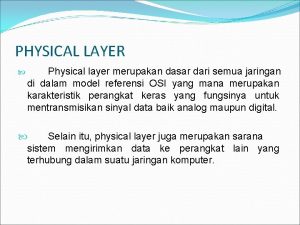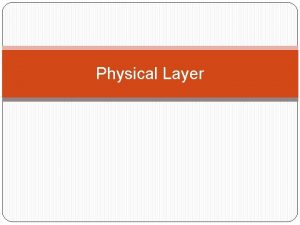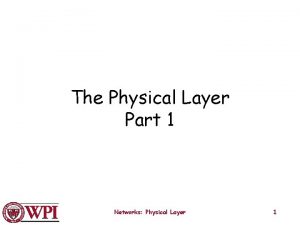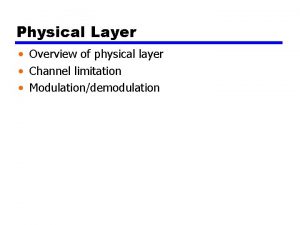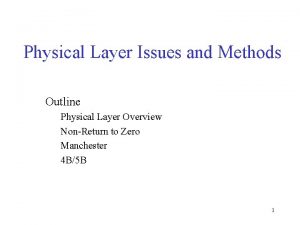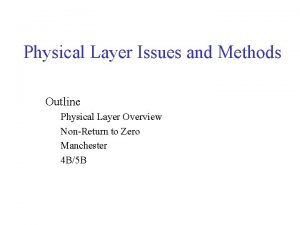Physical Architecture Layer Design Slide 1 Physical Architecture
































- Slides: 32

Physical Architecture Layer Design Slide 1

Physical Architecture �Software Components ◦ Data Storage ◦ Data Access Logic ◦ Application logic ◦ Presentation logic �Hardware Components ◦ Client computers ◦ Servers ◦ Connecting network Slide 2

1 Tier-Architecture �Client is a terminal �Server has functions of ◦ Presentation logic ◦ Application logic ◦ Data access logic ◦ Data storage Slide 3

Server Based Architecture Slide 4

Client-Server Architectures �Thin Client/Fat Server ◦ Client is little more than a terminal ◦ Server handles all processing �Fat Client/Thin Server ◦ Client does all processing ◦ Server may just store data Slide 5

Thick Client Slide 6

Server has Data 2 -Tiered Architecture Slide 7

Client has Presentation Logic 3 -tiered Architecture Slide 8

N-tiered Architecture Slide 9

Client-Server Benefits �Scalable �Support multiple clients and servers �Using Internet Standards Presentation logic can be separated �Multiple servers make for a generally more reliable network Slide 10

Middleware �Middleware is a type of system software designed to translate between different vendors’ software. �Middleware is installed on both the client computer and the server computer. �The client software communicates with the middleware that can reformat the message into a standard language that can be understood by the middleware that assists the server software Slide 11

SOA as “A paradigm for organizing and utilizing distributed capabilities that may be under the control of different ownership domains. It provides a uniform means to offer, discover, interact with and use capabilities to produce desired effects consistent with measurable preconditions and expectations”. Slide 12

Client-Server Limitations �Complexity �Updating the network computers is more complex Slide 13

Distributed Objects Computing �This is commonly called middleware �DOC allows the developer to simply concentrate on the users, objects, and methods of an application instead of worrying about which server contains which set of objects. The client object simply requests the “network” to locate and execute the server object’s method. Slide 14

Selecting a Physical Architecture �Cost of Infrastructure �Cost of Development �Ease of Development �Interface Capabilities �Control and Security �Scalability Slide 15

Characteristics Slide 16

Deployment Diagram Components �Nodes ◦ Any piece of hardware in the model �Artifacts ◦ Piece of the information system such as software component, database table, … �Communication paths ◦ Links between nodes of the network Slide 17

Deployment Diagram Slide 18

Deployment Diagram (cont. ) Slide 19

Diagram Examples Slide 20

The Network Model �The network model is a diagram that shows the major components of the information system (e. g. , servers, communication lines, networks) and their geographic locations throughout the organization. Slide 21

Network Model Example Slide 22

Non. Functional Requirements �Operational ◦ Specify the operating environment �Technical Environment ◦ Type of hardware and software �System Integration ◦ Interaction with other systems �Portability ◦ Response to changing environments �Maintainability ◦ Expected business requirement changes Slide 23

Performance Requirements �Speed ◦ Response time of the system ◦ Transaction update time �Capacity ◦ Number of users ◦ Volume of data �Availability and Reliability ◦ Specify available times ◦ Permissible failure rate �Security ◦ Protect from disruption and data loss Slide 24

Security Slide 25

Availability % Downtime per year Downtime per month* Downtime per week 90% ("one nine") 36. 5 days 72 hours 16. 8 hours 95% 18. 25 days 36 hours 8. 4 hours 97% 10. 96 days 21. 6 hours 5. 04 hours 98% 7. 30 days 14. 4 hours 3. 36 hours 99% ("two nines") 3. 65 days 7. 20 hours 1. 68 hours 99. 5% 1. 83 days 3. 60 hours 50. 4 minutes 99. 8% 17. 52 hours 86. 23 minutes 20. 16 minutes 99. 9% ("three nines") 8. 76 hours 43. 2 minutes 10. 1 minutes 99. 95% 4. 38 hours 21. 56 minutes 5. 04 minutes 99. 99% ("four nines") 52. 56 minutes 4. 32 minutes 1. 01 minutes 99. 999% ("five nines") 5. 26 minutes 25. 9 seconds 6. 05 seconds 99. 9999% ("six nines") 31. 5 seconds 2. 59 seconds 0. 605 seconds Slide 26

Cultural and Political �Multilingual �Customization �Making unstated norms explicit �Legal requirements Slide 27

Cultural and Political Rqrts. Slide 28

Synopsis Slide 29

Sample Specifications Slide 30

Summary � ◦ ◦ ◦ � Physical Architecture Layer Choose server vs. client-server Middleware Assess strengths and weaknesses Infrastructure design Various clients Network equipment Nonfunctional Requirements Operational Performance Security Hardware and software specification Slide 31

Seminars �Component-Based Software Engineering. �Storage Area Network. Slid e 32
 Physical architecture layer design
Physical architecture layer design Physical architecture layer design
Physical architecture layer design Physical architecture layer design
Physical architecture layer design Heel and toe step
Heel and toe step Pigmented layer and neural layer
Pigmented layer and neural layer Chemical digestion
Chemical digestion Secure socket layer and transport layer security
Secure socket layer and transport layer security Presentation layer functions
Presentation layer functions Secure socket layer and transport layer security
Secure socket layer and transport layer security Secure socket layer and transport layer security
Secure socket layer and transport layer security Secure socket layer and transport layer security
Secure socket layer and transport layer security Layer 2 e layer 3
Layer 2 e layer 3 Layer-by-layer assembly
Layer-by-layer assembly Layer 2 vs layer 3 bitstream
Layer 2 vs layer 3 bitstream Slide divide slide
Slide divide slide Conceptual design database
Conceptual design database Service mesh
Service mesh Application strategy example
Application strategy example Ftp, telnet belongs to which layer in edi architecture?
Ftp, telnet belongs to which layer in edi architecture? Classic ethernet physical layer
Classic ethernet physical layer What is the purpose of osi physical layer
What is the purpose of osi physical layer Osi model
Osi model Physical layer function
Physical layer function Physical layer transmission media
Physical layer transmission media Ois 7계층
Ois 7계층 Fppt
Fppt Physical layer coding violations
Physical layer coding violations Characteristics of physical layer
Characteristics of physical layer Physical layer encoding
Physical layer encoding The physical layer concerns with
The physical layer concerns with Physical layer encoding
Physical layer encoding Layer 1 hub
Layer 1 hub What is the basic purpose of the osi physical layer
What is the basic purpose of the osi physical layer
